

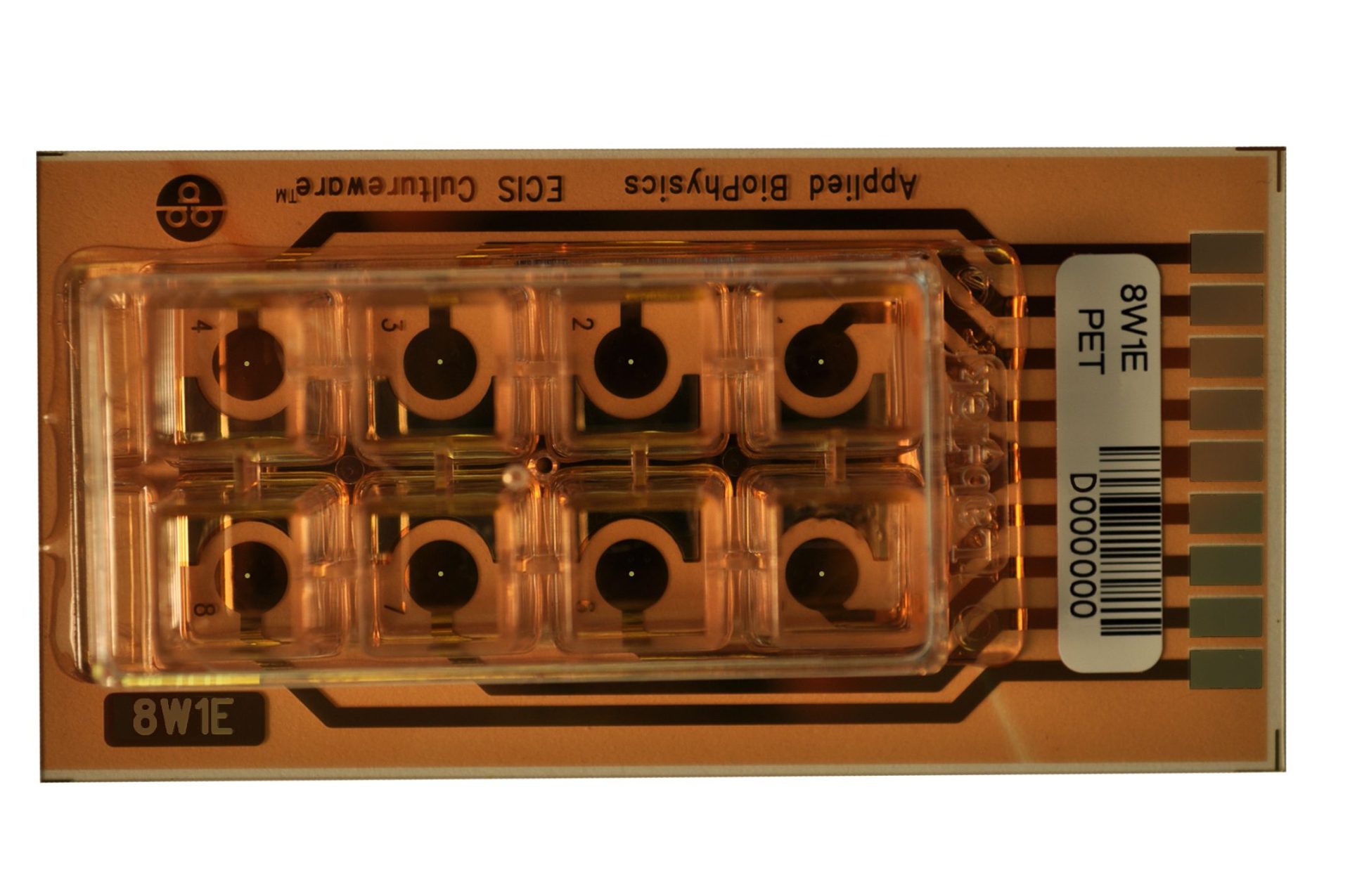
8W1E PET oder PC
Alle 8 Wells enthalten eine einzelne kreisförmige 250 Μm große aktive Elektrode. Jedes der Wells hat eine Substratfläche von 0,8 cm2 und ein maximales Volumen von 600 Μl. Im Durchschnitt werden bei konfluenten Kulturen 50 bis 100 Zellen von einer Elektrode erfasst, aber auch einzelne Zellen können beobachtet werden.
Anwendungen:
Zell-Zellkontakte (Barrierefunktion) Signaltransduktionassays, Zellinvasion, In-situ Zellelektroporation und Messung, Zellmigration / Wundheilung, zugehörige Mikroskopie und ECIS-Experimente.

Alle 8 Wells enthalten jeweils zehn kreisförmige 250 Μm große aktive Elektroden. Jedes der Wells hat eine Substratfläche von 0,8 cm2 und ein maximales Volumen von 600 Μl. Mit einer gleichmäßigen Zellschicht werden im Durchschnitt 500 bis 1.000 Zellen von einer Elektrode erfasst.
Anwendungen:
Zelladhäsion und -wachstum, Zellproliferation, Zelldifferenzierung, Zell-Zellkontakte, Zellinvasion, Signaltransduktionsassays, Zytotoxitizität.

Die 8 Wells des Arrays enthalten jeweils zwei Sets von 20 kreisförmigen, 250 Μm großen, aktiven und fingerförmigen Elektroden, um die Messung der Zellen auf 40 Elektroden zu ermöglichen. Jedes der Wells hat eine Substratfläche von 0,8 cm2 und ein maximales Volumen von 600 Μl. Mit einer gleichmäßigen Zellschicht werden im Durchschnitt 2.000 bis 4.000 Zellen von einer Elektrode erfasst.
Die 10E+ Arrays eignen sich für die Beobachtung einer größeren Zellanzahl durch Messung des gesamten Wellbodens. Durch die relative hohe Anzahl an Zellen werden Unterschiede in der Impedanz, die auf die Bewegungen einzelner Zellen (sog. Micromotions) zurückzuführen sind, ausgeglichen.
Anwendungen:
Zelladhäsion, -wachstum und -ausbreitung, Zelldifferenzierung, Zell-Zellkontakte (Barrierefunktion), Zellinvasion, Signaltransduktionsassays, Zytotoxitizität, Zell-ECM Proteininteraktionen.

Alle 8 Wells haben eine Gesamtelektrodenfläche von 3.982 mm2 auf fingerförmig miteinander verschränkten Elektrodenbereichen (idf), welche jeweils Zellmessungen durchführen.
Jedes der Wells hat eine Substratfläche von 0,8 cm2 und ein maximales Volumen von 600 Μl. Mit einer gleichmäßigen Zellschicht werden im Durchschnitt 4.000 bis 8.000 Zellen von einer Elektrode erfasst.
Die 8W20idf Arrays sind für die Beobachtung einer größeren Zellanzahl durch Messung des gesamten Wellbodens gedacht. Durch die relative hohe Anzahl an Zellen werden Unterschiede in der Impedanz, die auf die Bedingungen des Experiments zurückzuführen sind, ausgeglichen.
Anwendungen:
Zelladhäsion, -wachstum und -ausbreitung, Zytotoxitizität.
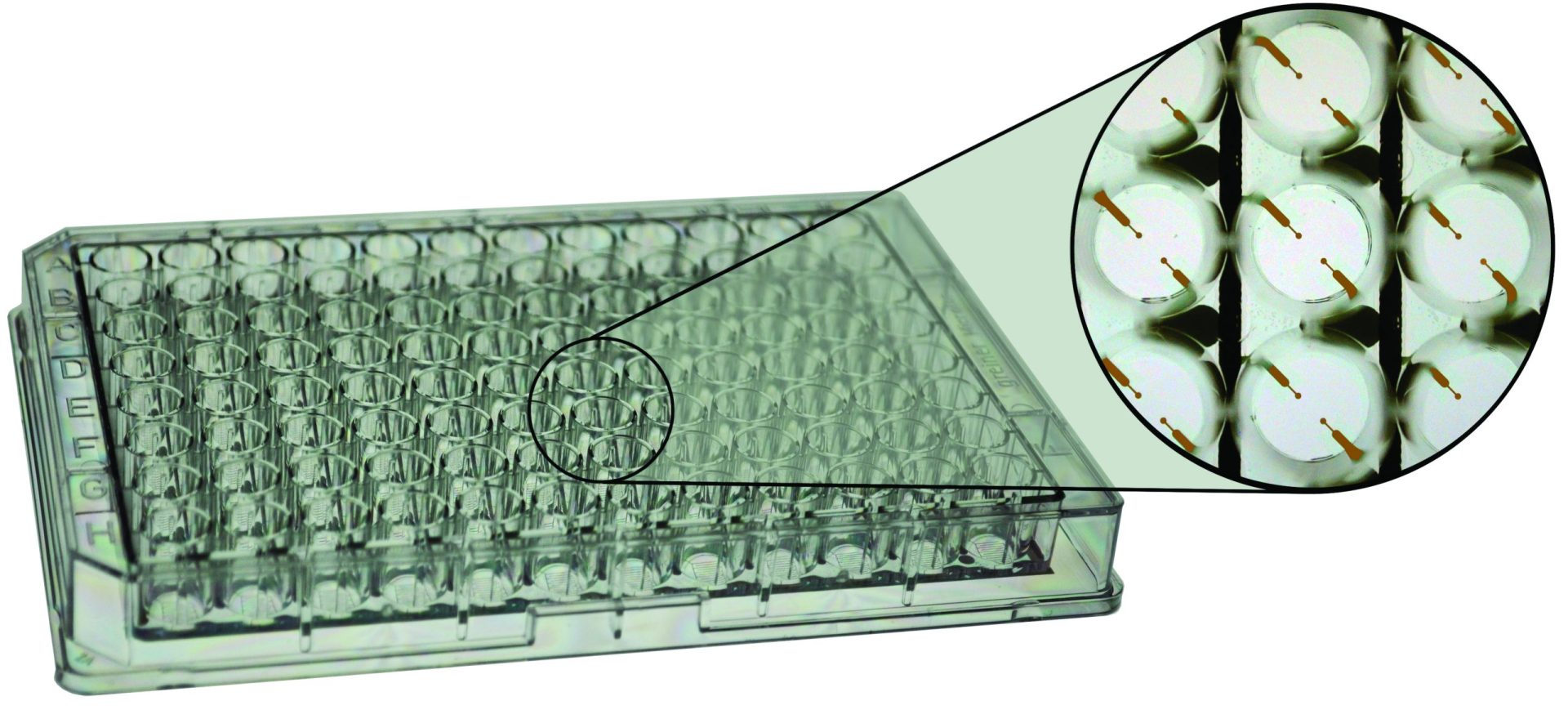
Die 96 Wells sind im Standardplattenformat angeordnet und enthalten zwei kreisförmige 350 Μm große aktive Elektroden auf einem transparenten PET-Substrat (Messung von 100 bis 200 Zellen). Ähnlich zu anderen 1E Arrays ist eine wichtige Anwendung die ECIS® Wundheilung, wobei ein starker Stromimpuls durch die kleinen Elektroden das Abtöten der Zellen garantiert.
Nur eine geringe Anzahl an Zellen wird von den kleinen Elektroden erfasst, so dass es eine hohe Fluktuation der Impedanz gibt, die auf zufällige Zellbewegungen zurückzuführen ist (Microbewegung).
Anwendungen:
Zell-Zellkontakte (Barrierefunktion), Signaltransduktionsassays, Zell-ECM Proteininteraktionen, Zellmigration, Messung von Mikrobewegungen, Detektion der Invasion von endothelialen Zellen durch metastatische Zellen, In situ Elektroporation und Messung.
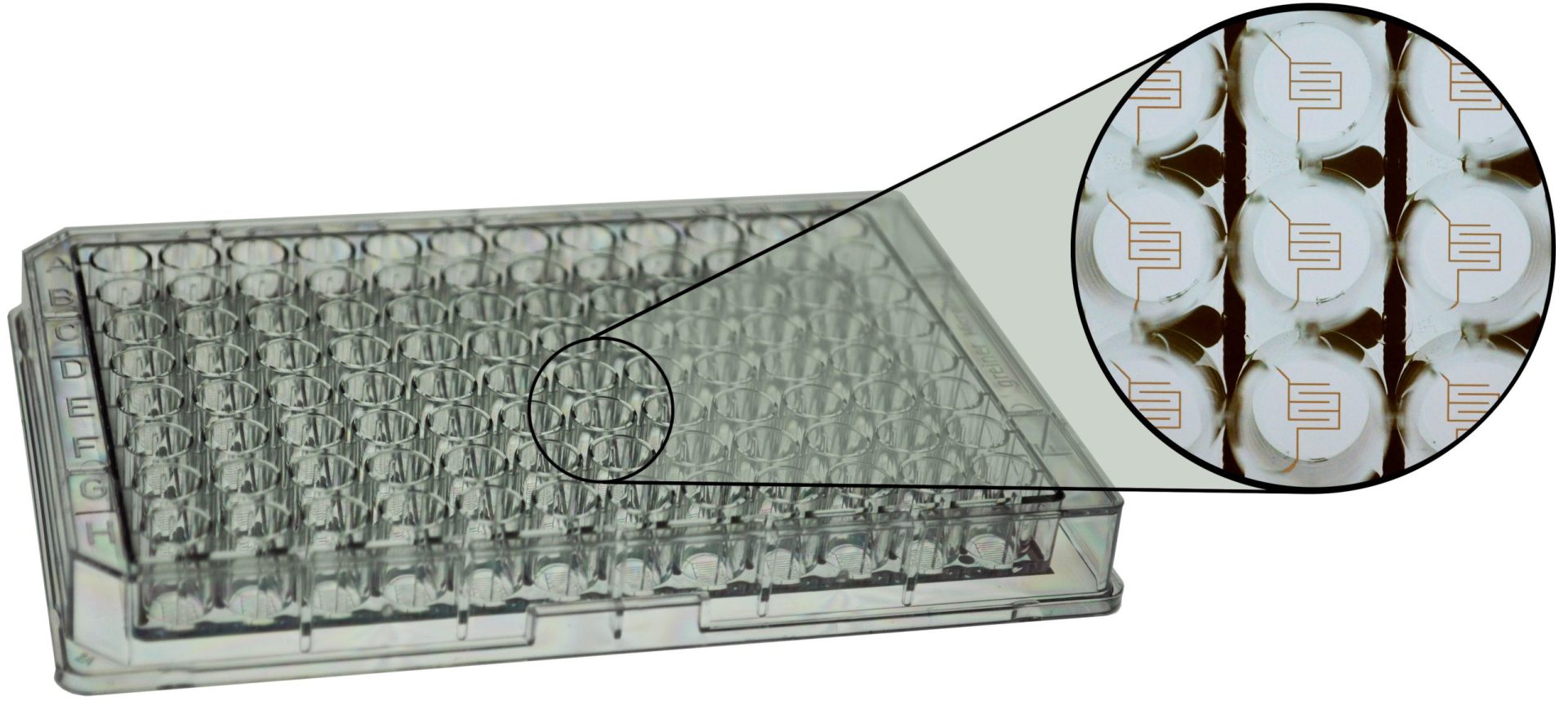
Alle 96 Wells sind auf fingerförmig miteinander verschränkten Elektrodenbereichen (idf). Die komplette Elektrodenfläche ist 2,09 mm2 und erfasst eine maximale Anzahl von 2.000 bis 4.000 Zellen.
Anwendungen:
Zell-Zellkontakte (Barrierefunktion), Signaltransduktionsassays, Zell-ECM Proteininteraktionen, Detektion der Invasion von endothelialen Zellen durch metastatische Zellen, Zellausbreitung.

Dieses Array wird aufgrund seiner Form auch Medusa Array genannt. Die Wells dieses Arrays haben jeweils zwei unabhängige, einzelne 250 Μm große aktive Elektroden. Das Medusa Array ist gut geeignet, um doppelte Messungen vorzunehmen oder um in einem Well Wundheilung zu simulieren, während das andere als Kontrolle dient.
Bei Verbindung mit der Array Station werden nur die oberen vier Wells gemessen. Um die anderen vier Wells zu messen, muss das Array umgedreht werden, so dass deren Kontaktstellen mit der Station verbunden werden.
Anwendungen:
Zell-Zellkontakte (Barrierefunktion), Signaltransduktionsassays, Zellinvasion, In-situ Zellelektroporation und Messung, Zellmigration / Wundheilung, zugehörige Mikroskopie und ECIS-Experimente.

Dieses Array wird genutzt, um die Bewegung von Zellen in Reaktion auf chemische Gradienten zu erfassen und wird für Chemotaxis-Messungen verwendet, erstmals beschrieben durch Hadjout, N. et al. (2001) Biotechniques 21 (5) 1130. Die messende Elektrode ist ein dünnes Goldfilament zwischen zwei Markierungen.
Die Wells haben eine Substratfläche von 0,8 cm2 und ein maximales Volumen von 600 Μl. Mit einer konfluenten Zellschicht werden im Durchschnitt 50 bis 100 Zellen von einer Elektrode erfasst.
Anwendungen:
Chemotaxis

Die 8 Wells enthalten jeweils eine einzelne lineare Elektrode mit Dimensionen von 667 Μm x 150 Μm und sich ergebenden Messwerten vergleichbar mit denen einer Standard-kreisförmigen 250 Μm großen Elektrode. Die Wells haben eine Substratfläche von 0,8 cm2 und ein maximales Volumen von 600 Μl. Mit einer konfluenten Zellschicht werden im Durchschnitt 200 bis 400 Zellen von einer Elektrode erfasst, aber auch einzelne Zellen können beobachtet werden.
Anwendungen:
Zellmigration / Wundheilung, zugehörige Mikroskopie und ECIS-Experimente.
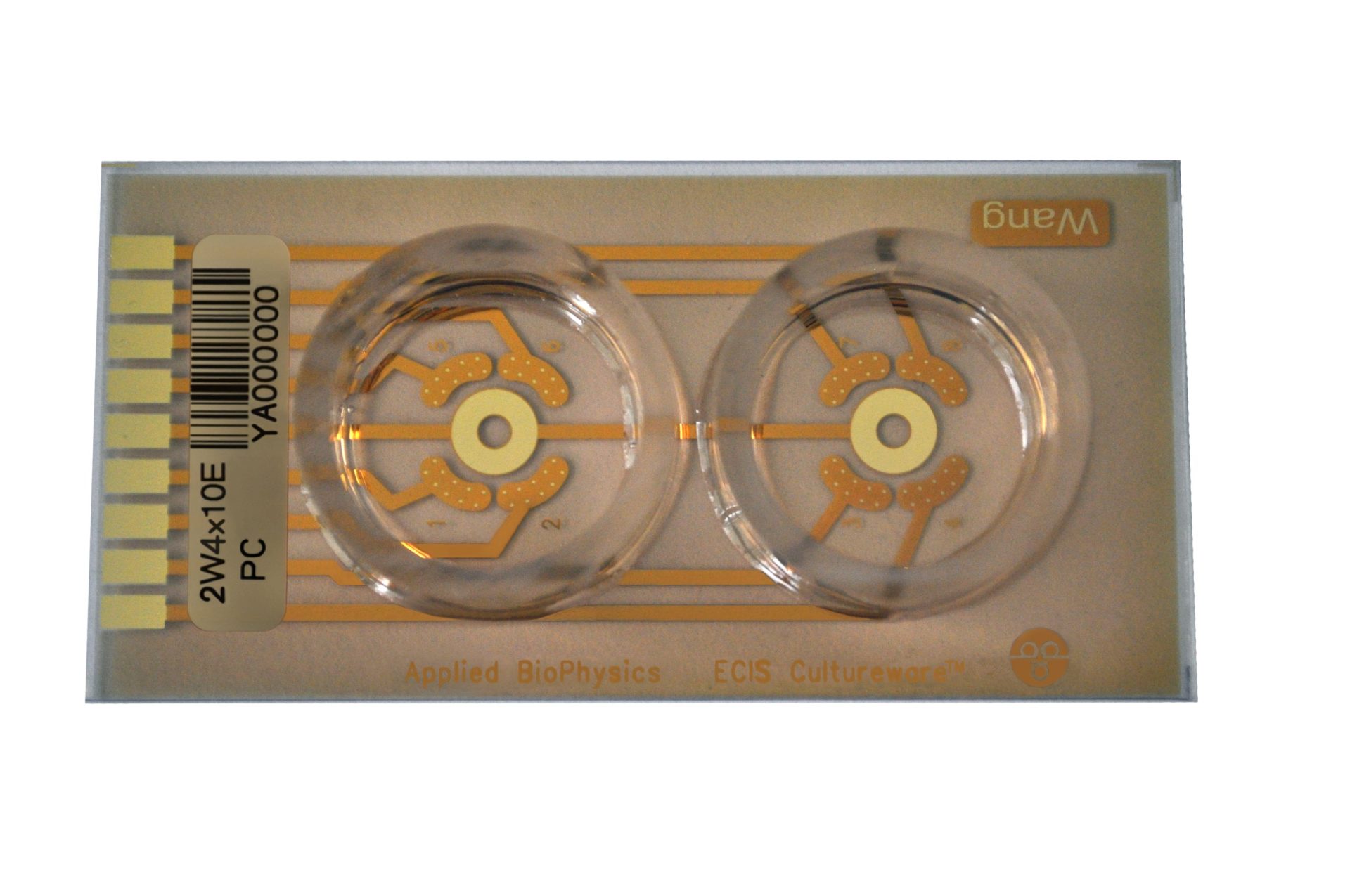
Diese Arrays mit zwei kreisförmigen und 25 mm großen Wells enthalten vier unabhängige Sets von jeweils zehn 250 Μm großen aktiven Elektroden, von denen jede 2.000 bis 4.000 Zellen erfassen kann. Außerdem ist das 2W4x10E Array nützlich, um Vergleichsmessungen im selben Well durchzuführen oder um in einem Well Wundheilung zu simulieren, während das andere als Kontrolle dient.
Anwendungen:
Zell-Zellkontakte (Barrierefunktion), Signaltransduktionsassays, Zellinvasion, -adhäsion, -wachstum und -ausbreitung, Zelldifferenzierung, Zytotoxitizität, zugehörige Mikroskopie und ECIS-Experimente.

Durchflussarrays sind für ECIS-Messungen von Zellen unter Strömung geeignet oder, um Scherstress, dem endotheliale Zellen in vivo ausgesetzt sind, zu simulieren.
1F8x1E PC
Hierbei handelt es sich um ein spezielles Durchflussarray mit 8 aktiven 250 Μm großen Elektroden (jede kann 50 – 100 Zellen messen), die im Zentrum des Arrays direkt unterhalb eines Durchflusskanals lokalisiert sind. Der Durchflusskanal misst 50 mm in der Länge, 5 mm in der Tiefe und 0,36 mm in der Höhe und hat eine Kapazität von 90 Μl.
Anwendungen:
Zell-Zellkontakte (Barrierefunktion), Signaltransduktionsassays, Zellinvasion, In situ Zellelektroporation und -messung, Zellmigration / Wundheilung, Zellausbreitung und -differenzierung, Zytotoxitizität.
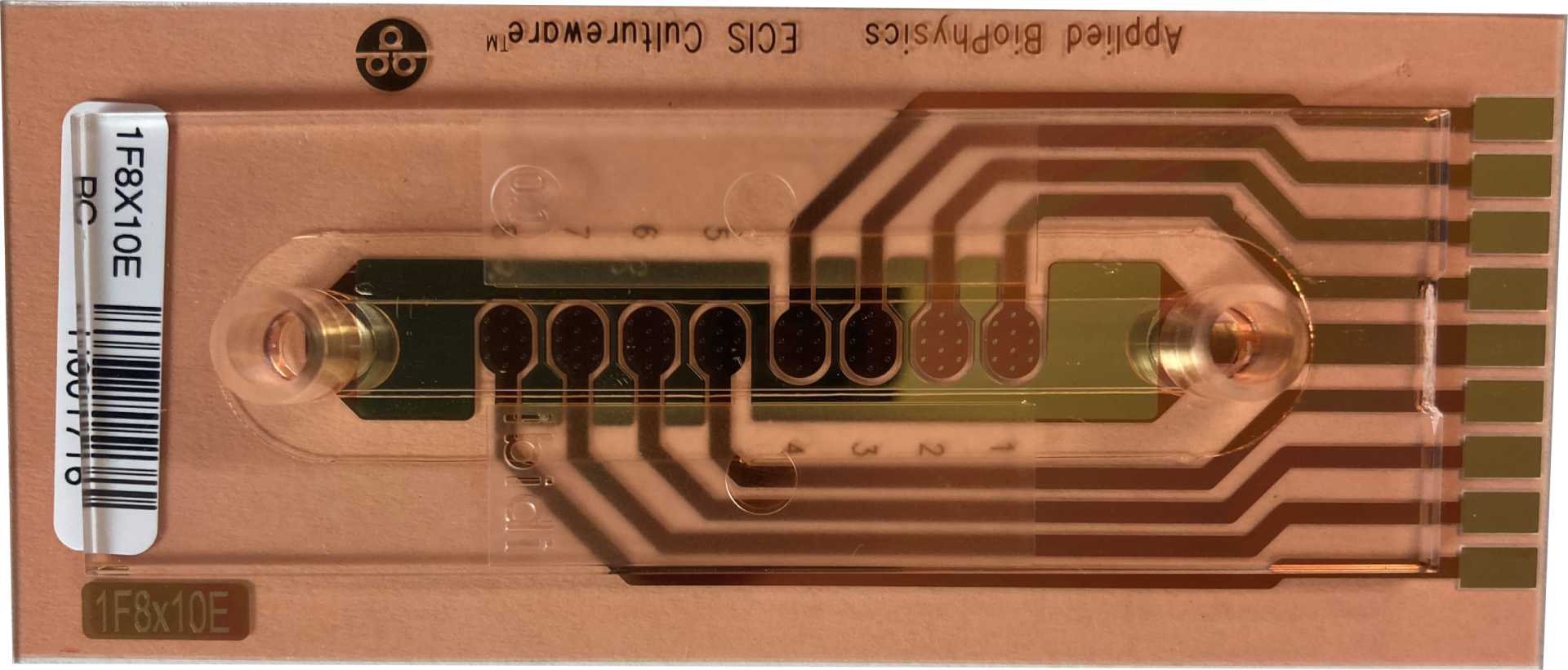
Hierbei handelt es sich um ein spezielles Durchflussarray mit 8×10 aktiven 250 Μm großen Elektroden (jede kann 500 – 1.000 Zellen messen). Die Elektroden liegen im Zentrum des Arrays direkt unterhalb eines Durchflusskanals, der 50 mm in der Länge, 5 mm in der Tiefe und 0,36 mm in der Höhe misst und eine Kapazität von 90 Μl hat.
Anwendungen:
Zell-Zellkontakte (Barrierefunktion), Signaltransduktionsassays, Zellinvasion, In situ Zellelektroporation und -messung, Zellmigration / Wundheilung, Zellausbreitung und -differenzierung, Zytotoxitizität.
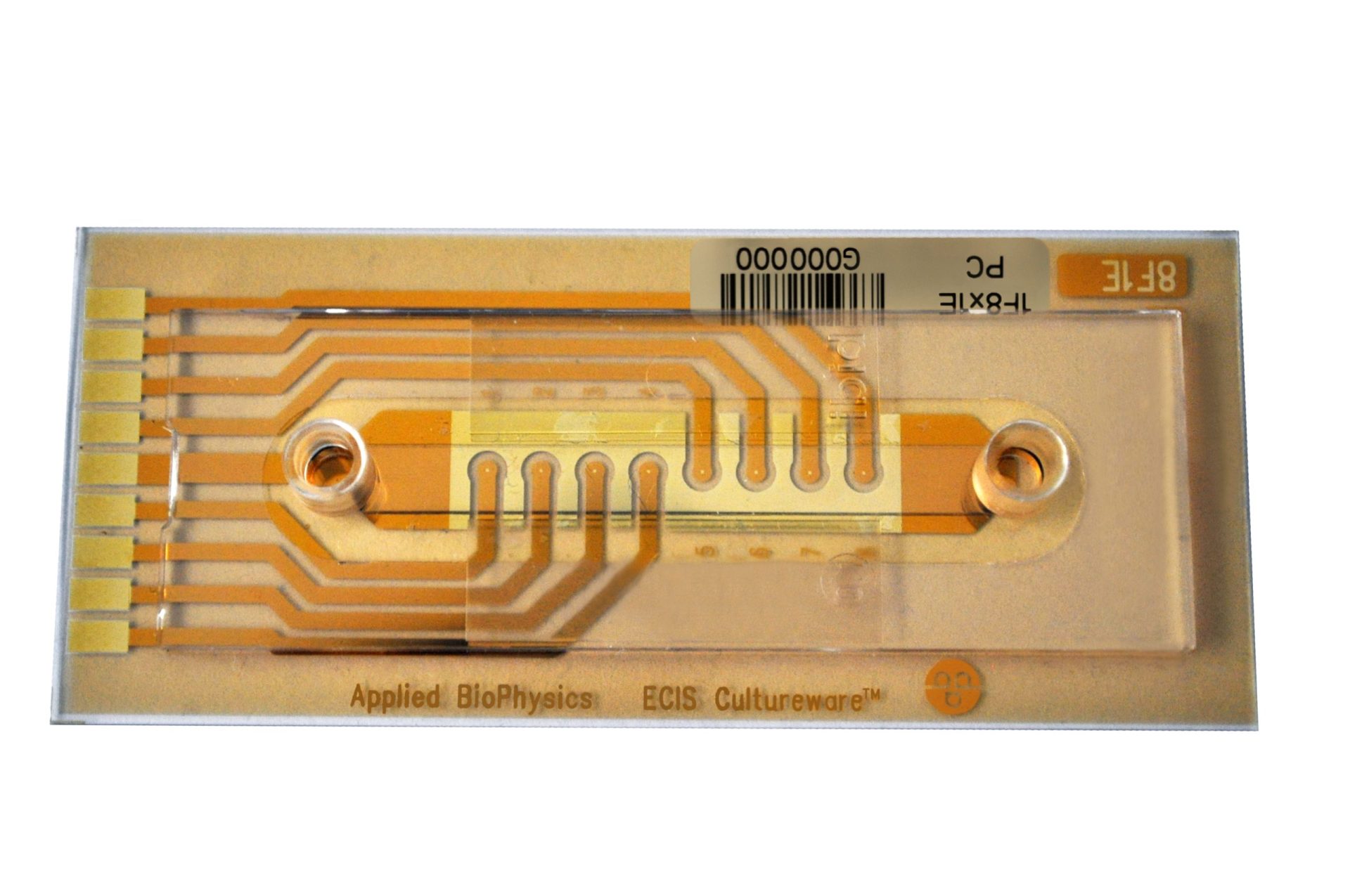
Dieses Durchflussarray ermöglicht Gefäßverzweigungsassays (sog. Bifurkationsassays) und die Simulation von Blutgefäßen. Das Array teilt sich in einen 30° Y-Kanal in die eine Richtung und einen 45° Y-Kanal in die andere Richtung auf.
Das Array hat zwei Enden mit jeweils 8 messbaren Kanälen an jedem Ende. Alle acht Messpunkte, jeder mit 4 kreisförmigen Elektroden (0,49 mm2 Elektrodenfläche zur Messung von 500 bis 1.000 Zellen, gleiche Fläche wie bei der 10E Elektrode) sind im Kanal und im Y-Teil des Arrays lokalisiert. Das eine Ende des Arrays nimmt den 30° Y-Kanal und das andere Ende den 45° Y-Kanal auf. Die Elektroden befinden sich in den Ecken der Übergangspunkte der Flussrichtung. Die Kanäle haben ein Volumen von 165 Μl und die Reservoire 60 Μl. Der Fluss ist immer laminar. Turbulente Strömungen sind nicht möglich. Für die Simulation dieser wird eine Oszillation des Flusses empfohlen.
Empfehlungen für die folgenden Anwendungen bei Scherstressbedingungen:

Nutzen Sie die erweiterte Suche, um gezielt nach Produkten und Herstellern in unserem Sortiment zu filtern. Geben Sie einfach den gewünschten Hersteller ein oder verwenden Sie die verfügbaren Filter, um Ihre Auswahl einzugrenzen. So finden Sie schnell und präzise das passende Laborgerät für Ihren Bedarf.
Sie sehen gerade einen Platzhalterinhalt von Vimeo. Um auf den eigentlichen Inhalt zuzugreifen, klicken Sie auf die Schaltfläche unten. Bitte beachten Sie, dass dabei Daten an Drittanbieter weitergegeben werden.
Mehr InformationenSie sehen gerade einen Platzhalterinhalt von YouTube. Um auf den eigentlichen Inhalt zuzugreifen, klicken Sie auf die Schaltfläche unten. Bitte beachten Sie, dass dabei Daten an Drittanbieter weitergegeben werden.
Mehr InformationenSie müssen den Inhalt von reCAPTCHA laden, um das Formular abzuschicken. Bitte beachten Sie, dass dabei Daten mit Drittanbietern ausgetauscht werden.
Mehr Informationen